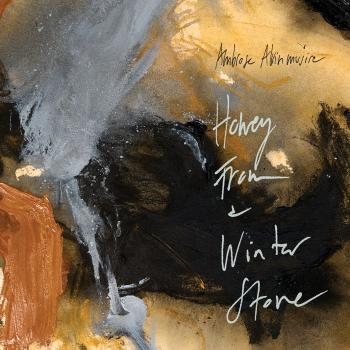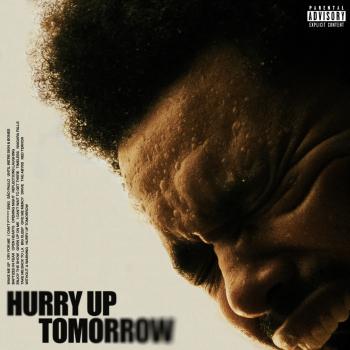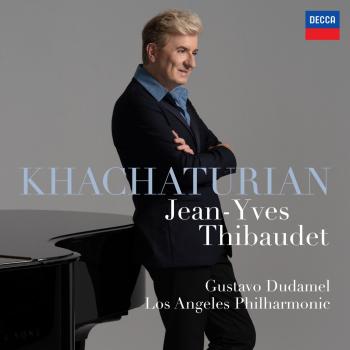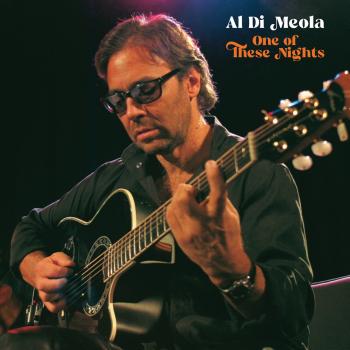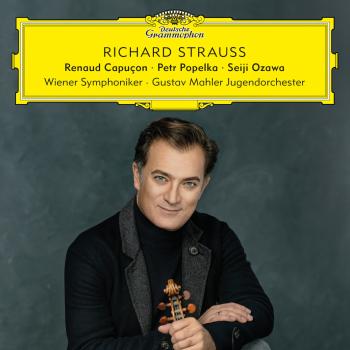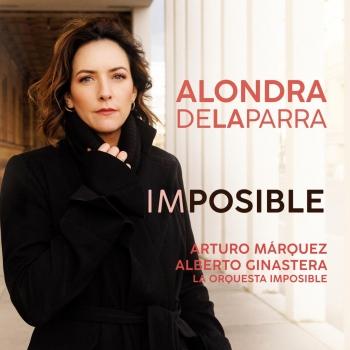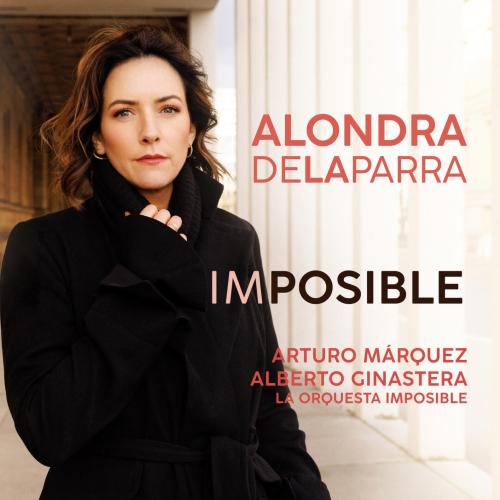
Imposible Alondra de la Parra
Album info
Album-Release:
2024
HRA-Release:
27.06.2024
Label: Alondra de la Parra Borja
Genre: Classical
Subgenre: Orchestral
Artist: Alondra de la Parra
Composer: Arturo Marquez (1950), Alberto Ginastera (1916-1983)
Album including Album cover
I`m sorry!
Dear HIGHRESAUDIO Visitor,
due to territorial constraints and also different releases dates in each country you currently can`t purchase this album. We are updating our release dates twice a week. So, please feel free to check from time-to-time, if the album is available for your country.
We suggest, that you bookmark the album and use our Short List function.
Thank you for your understanding and patience.
Yours sincerely, HIGHRESAUDIO
- Arturo Márquez (b. 1950): La Sinfonía Imposible: Las Peras del Olmo (2022):
- 1 La Sinfonía Imposible: Las Peras del Olmo (2022): 1. Cambio Climático (Principio), para Orquesta (En Vivo) 02:53
- 2 La Sinfonía Imposible: Las Peras del Olmo (2022): 2. Resiliencia, para Corno Francés y Orquesta Felix Klieser, Corno Francés (En Vivo) 04:34
- 3 La Sinfonía Imposible: Las Peras del Olmo (2022): 3. Equidad (de Género), para Dos Violonchelos y Orquesta Michal Korman y Rolando Fernández, Violonchelos (En Vivo) 05:16
- 4 La Sinfonía Imposible: Las Peras del Olmo (2022): 4. Sin Retorno (Migración), para Clarinete, Trompeta y Orquesta Sacha Rattle, Clarinete y Pacho Flores, Trompeta (En Vivo) 04:35
- 5 La Sinfonía Imposible: Las Peras del Olmo (2022): 5. Magicicada (Empatía), para Flauta, Contrabajo y Orquesta Gili Schwarzman, Flauta y Edicson Ruiz, Contrabajo (En Vivo) 05:33
- 6 La Sinfonía Imposible: Las Peras del Olmo (2022): 6. Controversia , para Dos Violines y Orquesta de Cuerdas Guy Braunstein y Nemanja Radulovic, Violines (En Vivo) 05:20
- 7 La Sinfonía Imposible: Las Peras del Olmo (2022): 7. Utopía Mayor, para Trombón Tenor, Trombón Bajo y Orquesta Jörgen van Rijen, Trombón Tenor y Stefan Schulz, Trombón Bajo (En Vivo) 05:23
- 8 La Sinfonía Imposible: Las Peras del Olmo (2022): 8. Cambio Climático (Final), para Orquesta (En Vivo) 03:28
- Alberto Ginastera (1916 - 1983): Variaciones Concertantes, Op. 23 (1953):
- 9 Variaciones Concertantes, Op. 23 (1953): I. Tema per Violoncello ed Arpa Rolando Fernández, Violonchelo y Kristi Shade, Arpa (En Vivo) 02:00
- 10 Variaciones Concertantes, Op. 23 (1953): II. Interludio per Corde (En Vivo) 01:35
- 11 Variaciones Concertantes, Op. 23 (1953): III. Variazione Giocosa per Flauto Matvey Denim, Flauta (En Vivo) 01:03
- 12 Variaciones Concertantes, Op. 23 (1953): IV. Variazione in Modo di Scherzo per Clarinetto Sacha Rattle, Clarinete (En Vivo) 02:08
- 13 Variaciones Concertantes, Op. 23 (1953): V. Variazione Drammatica per Viola Karen Forster, Viola (En Vivo) 03:05
- 14 Variaciones Concertantes, Op. 23 (1953): VI. Variazione Canonica per Oboe e Fagotto Tamar Inbar, Oboe y Virya Quesada, Fagot (En Vivo) 02:17
- 15 Variaciones Concertantes, Op. 23 (1953): VII. Variazione Ritmica per Tromba e Trombone Pacho Flores, Trompeta y Jörgen van Rijen, Trombón / VIII. Variazione in Modo di Moto Perpetuo per Violino Shari Mason, Violín (En Vivo) 01:48
- 16 Variaciones Concertantes, Op. 23 (1953): IX. Variazione Pastorale per Corno Matías Piñeira, Corno (En Vivo) 02:07
- 17 Variaciones Concertantes, Op. 23 (1953): X. Interludio per Fiati (En Vivo) 01:16
- 18 Variaciones Concertantes, Op. 23 (1953): XI. Ripresa dal Tema per Contrabasso Edicson Ruiz, Contrabajo (En Vivo) 01:55
- 19 Variaciones Concertantes, Op. 23 (1953): XII. Variazione Finale in Modo di Rondo per Orchestra (En Vivo) 03:37
Info for Imposible
An (Im)possible Symphony
“The Impossible Symphony “Shows once again how limitless Arturo Márquez’s musical imagination is,” says Alondra de la Parra. “The way he addresses the big questions of our time here is absolutely stunning in its scope and quality. Taking the fifth movement, ‘Magicicada’, as an example, Márquez is inspired by the empathy shown by two species of cicadas that tune into each other’s life cycles to allow both species to thrive. He represents these two cicadas in the score with flute and double bass as they cohabit around each other until their lines meet on D, the only note they have in common. Gender equality is the inspiration of the third movement, reminding us of the additional struggles that society imposes on women in their daily lives. This is represented by two cellos, male and female, playing in canon, but the conditions are more difficult for the woman, since her part is octaved. The division of the strings in this movement is also special: the division It is sorted by genre, not by tuning. Therefore, the work can only be performed if the strings are divided equally. In the sixth movement, ‘Controversy’, two stubborn violin virtuosos seem at odds, although in reality they are saying the same thing. In the seventh movement, ‘Major Utopia’, the trombones play only major chords, wondering what the meaning of happiness is. This piece not only reflects on the difficulty of finding happiness, but it was also the most difficult movement for him to compose due to his experience as a trombonist. “The symphony constitutes a technical challenge for musicians and invites the public to reflect on the current struggles facing humanity.”
A deep friendship
The Impossible Symphony was not the first time that Alondra de la Parra and Arturo Márquez collaborated together. Rather, they have been important musical companions. “His extraordinary music is part of my basic repertoire. I don’t think I have performed any work as often as the Danzón No. 2 by Arturo Márquez,” comments Alondra de la Parra.
She adds that their paths have crossed again and again, including when de la Parra founded the Philharmonic Orchestra of the Americas in 2004, but their friendship became especially close during the pandemic. The first piece performed by The Impossible Orchestra was also the Danzón No. 2. It was recorded to raise funds for Mexican women and children affected by violence, and Arturo generously advised and supported the project.
The (Im)possible Orchestra
At the height of the pandemic, many things seemed impossible, especially orchestral music: the danger posed by such a large gathering of people was too high. However, The Impossible Orchestra by Alondra de la Parra showed that music, as a basic human need, always finds a way. For the founding of the orchestra in 2020, the director contacted some of the best soloists in the world of classical music: Guy Braunstein, Felix Klieser, Sarah Willis, Rolando Villazón and many other musicians who under other circumstances would never have met. heard in the same orchestra. The members of this seemingly “impossible” ensemble recorded their parts under strict sanitary conditions in studios in six different cities around the world and presented their version of the Danzón No. 2 in a digital format. The Impossible Orchestra had been born and this first project was a great success. But it didn’t stop there: For the Festival PAAX GNP in Mexico in 2022, Alondra de la Parra called for the first time The Impossible Orchestra as an orchestra in residence—and commissioned the Impossible Symphony for this occasion from Arturo Márquez, who composed it with some of the soloists of this orchestra in mind. The work has also been performed in Spain with the OSG and will now premiere in Germany.
La Orquesta Impossible
Alondra de la Parra, conductor
Alondra de la Parra
Alondra's energy, contagious radiance and artistic qualities have made her an internationally sought-after artist.
She has already conducted many of the most prestigious international orchestras: Orchestre de Paris, London Philharmonic Orchestra, BBC Philharmonic Orchestra, Zurich Tonhalle Orchestra, Orchestre du Festival de Verbier, Orchestre de la Suisse Romande, Sveriges Radios Symfoniorkester, Bamberger Symphoniker, Rundfunk-Sinfonieorchester Berlin, WDR Symphony Orchestra, the DR SymfoniOrkestret, the Camerata Salzburg, the Orchestra dell'Accademia Nazionale di Santa Cecilia, the Orchestra Sinfonica Nazionale della Rai Torino, the Orquesta y Coro Nacionales de España, the Orquesta Sinfónica de Galicia, the Orchestre Philharmonique de Monte Carlo, as well as the Orquestra Sinfônica do Estado de São Paulo.
In the 2022-2023 season, she conducted the complete Brahms symphonies with the Münchner Symphoniker and the world premiere of Joby Talbot's ballet 'Like Water for Chocolate' at London's Royal Opera House, given then at the New York's Metropolitan Opera.
Appointed Principal Guest Conductor of the Orchestra Sinfonica di Milano in 2022, she also became Principal Conductor and Artistic Director of the Orquesta y Coro de la Comunidad de Madrid in 2024.
In 2017, Alondra de la Parra became the first woman ever to be appointed music director of an Australian orchestra, at the helm of the Queensland Symphony Orchestra, a position she held until 2019.
In 2022, she created the first edition of the PAAX GNP festival in Mexico, welcoming artists such as Julian Prégardien, Guy Braunstein, Nemanja Radulovic, Pacho Flores and Aleksey Igudesman.
Alondra de la Parra appears regularly in the musical format "Musica Maestra", having recorded over 60 episodes to date. Since July 2017, Germany's Deutsche Welle has been broadcasting a series of web videos and television programmes in which the conductor appears as protagonist and reporter. Over the past three seasons, she has interviewed guests such as John Malkovich, Jan Lisiecki, Gautier Capuçon, Zenaida Yanowsky.
She co-created "The Silence of Sound", a multidisciplinary show - a philharmonic orchestra, a clown actress and a video installation - aimed at audiences of all ages, which have been touring through Mexico and Spain for the first time during the 2022-2023 season.
Alondra de la Parra has been represented by the RSBA agency since 2024.
Arturo Márquez
is one of the world’s most prominent and celebrated contemporary composers. His work masterfully combines classical music with traditional rhythms from Mexico, Latin America and Africa.
Danzón No. 2, the most famous of nine with that name, premiered in 1994 and quickly became the quintessential Mexican symphony. It carries a harmonic dialogue between orchestral music, Mexican ballroom dances and other popular melodies from Latin America. In 2019 it was the most frequently played classical music piece in the world.
This album contains no booklet.



